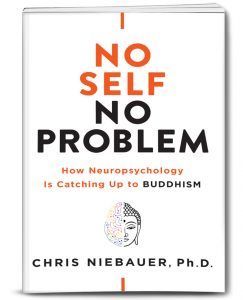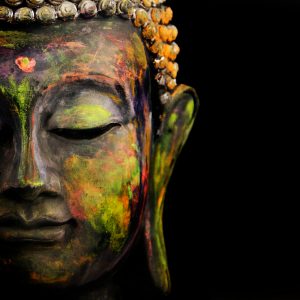Stop thinking, and end your problems.
-Lao Tzu, The Tao Te Ching (Stephen Mitchell translation)
Who are we? Why are we here? Why do we suffer?
Humans have grappled with these questions since time immemorial. Philosophers, spiritual leaders, scientists, and artists have all weighed in on them. In Western philosophy, the best answer to the question of who we are is that thinking is the defining characteristic of humanity There is no more concise example of this than philosopher Rene Descartes' famous statement cogito, ergo sum, or, "I think, therefore I am."
This reverence for thinking is in stark contrast to the tenets of Eastern philosophy found in traditions such as Buddhism, Taoism, and certain schools of Hinduism. These traditions at best advocate a distrust of the thinking mind and often go further to claim that the thinking mind is part of the problem rather than the solution. Zen Buddhism offers us the saying, "No thought, no problem."
The brain-powered individual, which is variously called the self, the ego, the mind, or "me," lies at the center of Western thought. In the worldview of the West, we herald the greatest thinkers as world-changers. But who is this? Let's take a closer look at the thinker, or the "me," we all take for granted. This definition will be essential throughout our discussion.
This "I" is for most of us the first thing that pops into our minds when we think about who we are. The "I" represents the idea of our individual self, the one that sits between the ears and behind the eyes and is "piloting" the body The "pilot" is in charge, it doesn't change very much, and it feels to us like the thing that brings our thoughts and feelings to life. It observes, makes decisions, and carries out actions-just like the pilot of an airplane.
This I/ego is what we think of as our true selves, and this individual self is the experiencer and the controller of things like thoughts, feelings, and actions. The pilot self feels like it is running the show. It is stable and continuous. It is also in control of our physical body; for example, this self understands that it is "my body" But unlike our physical body, it does not perceive itself as changing, ending (except, perhaps for atheists, in bodily death), or being influenced by anything other than itself.
Now let's turn to the East. Buddhism, Taoism, the Advaita Vedanta school of Hinduism, and other schools of Eastern thought have quite a different take on the self, the ego, or "me." They say that this idea of "me" is a fiction, although a very convincing one. Buddhism has a word for this concept-anatta, which is often translated as "no self'- which is one of the most fundamental tenets of Buddhism, if not the most important.
This idea sounds radical, even nonsensical, to those who are trained in Western traditions. It seems to contradict our everyday experience, indeed our whole sense of being.
This book will explore strong evidence suggesting that the concept of the self is simply a construct of the mind, rather than a physical thing located somewhere within the brain itself. Put another way, it is the process of thinking that creates the self, rather than there being a self having any independent existence separate from thought. The self is more like a verb than a noun. To take it a step further, the implication is that without thought, the self does not, in fact, exist. It's as if contemporary neuroscience and psychology are just now catching up with what Buddhist, Taoist, and Advaita Vedanta Hindu ism have been teaching for over 2,500 years.
This may be a difficult point to grasp, chiefly because we've mistaken the process of thinking as a genuine thing for so long. It will take some time to see the idea of a "me" as simply an idea rather than a fact. Your illusionary self-the voice in your head-is very convincing. It narrates the world, determines your beliefs, replays your memories, identifies with your physical body, manufactures your projections of what might happen in the future, and creates your judgments about the past. It is this sense of self that we feel from the moment we open our eyes in the morning to the moment we close them at night. It seems all-important, so it often comes as a shock when I tell people that based on my work as a neuropsychologist, this "I" is simply not there-at least not in the way we think it is.
On the other hand, this will come as no surprise to those who have studied Eastern religions and philosophical movements, since all of these take as a basic premise the idea that the self as we most commonly think of it does not exist. If this is true, one might then ask, what is left? This question is definitely worth pondering, and we will look at it later after we approach the idea of "no self' through the landscape of scientific findings that point to the unreality of the self and the possible presence of a different model of consciousness.
As I mentioned in the preface, the great success story of neuroscience has been in mapping the brain. We can point to the language center, the face processing center, and the center for understanding the emotions of others. Practically every function of the mind has been mapped to the brain with one important exception: the self. While various neuroscientists have made the claim that the self resides in this or that neural location, there is no real agreement among the scientific community about where to find it-not even whether it might be in the left or the right side of the brain. Perhaps the reason we can't find the self in the brain is because it isn't there.
Yet even if we accept as true that there is no self, we cannot deny that there is still a very strong idea of self. While neuropsychology has failed to find the seat of the self, it has determined the part of the brain that creates this idea of a self, and we will examine this in detail.
Why does all of this matter? In much the same way I found myself deep in suffering after the loss of my father, each of us will experience plenty of mental pain, misery, and frustration in our lifetimes. Mistaking the voice in our head for a thing and labeling it "me" brings us into conflict with the neuropsychological evidence that shows there is no such thing. This mistake-this illusory sense of self-is the primary cause of our mental suffering. What's more, I contend that it blocks access to the eternal, expansive thread of universal consciousness that is always available to us.
To be clear, mental suffering is different from physical pain. Pain occurs in the body and is a physical reaction - like when you stub your toe or break an arm. The suffering I speak of occurs in the mind only and describes things such as worry, anger, anxiety, regret, jealousy, shame, and a host of other negative mental states.
I know it's a big claim to say that all of these kinds of suffering are the result of a fictitious sense of self. For now, the essence of this idea is captured brilliantly by Taoist philosopher and author Wei Wu Wei when he writes, "Why are you unhappy? Because 99.9 percent of everything you think, and of everything you do, is for yourself-and there isn't one."
The Structure of This Book
We will start by looking at the brain, its left and right side, and its effects on human cognition and behavior.3 There are certainly other ways to organize and divide the brain that are important to the process of cognition, such as the hippocampus and the prefrontal cortex mentioned in the preface, but it is my aim to make this topic understandable and enjoyable for everyone. For simplicity's sake, we will mostly talk about the left and right sides of the brain and how they affect our thoughts and behaviors.
First, I will explain the idea that the left brain is an interpreter or story-maker. Pattern recognition, language, mapmaking, and categorization are all located in the left brain, and the evidence suggests that it is exactly these types of functions that collectively lead to the sensation of a self and the strong belief in its absolute truth. We will explore how the unique functions of the left brain give rise not only to the sense of self but also account for why it is so difficult to see beyond this illusion and why this sensation creates so much suffering in the human condition.
Once we understand how the left brain operates, we will take a closer look at the right brain and how it works, which includes things such as finding meaning, our ability to see and understand big-picture ideas, expressing creativity, experiencing emotions, and spatial processing. These are all functions that rely on the right brain. After we have examined both sides of the brain and the processes associated with each, I will speculate on what this information may mean for consciousness and how it could also point beyond the ego illusion and toward the mystery of who we really are.
At the end of each chapter, you will find a section called Explorations. These are exercises or simple thought experiments that provide a chance for a deeper, more hands-on understanding of the concepts dis cussed. Through these Explorations, I hope you will be able to access the central ideas of this book in novel and exciting ways that go beyond merely thinking about them.
What we discuss here will show that specific studies in neuroscience and psychology strongly suggest what Eastern philosophies have been saying for millennia: namely that this idea of "me" or the "self'' that most of us take for granted doesn't exist in the way that we think it does. This may be a new idea for you, and before we begin, I want to make clear that I am not simply trying to convince you that your ego is an illusion by heaping mountains of research on you. Rather, I want to guide you to new experiences and open pathways to using different parts of the brain so that you can determine for yourself whether all this is true or not. Einstein said that a problem cannot be solved with the same level of thinking that created it. In this way, the sense of self created by the left brain cannot be unveiled by hammering away at it with even more thinking from the left brain. My wish is to guide your consciousness to a different way of looking at your experiences and, in so doing, allow you to go beyond the thoughts of the left brain. I believe this can greatly reduce your mental suffering, as it has mine.
As the ancient Zen axiom states, "No self, no problem."
No Self, No Problem shows how findings in neuropsychology suggest that our sense of self is actually an illusion created by the left side of the brain and that it exists in the same way a mirage in the middle of the desert exists: as a thought rather than a thing.
Intrigued? This title will be released on September 10th and will be available from all major retailers!

